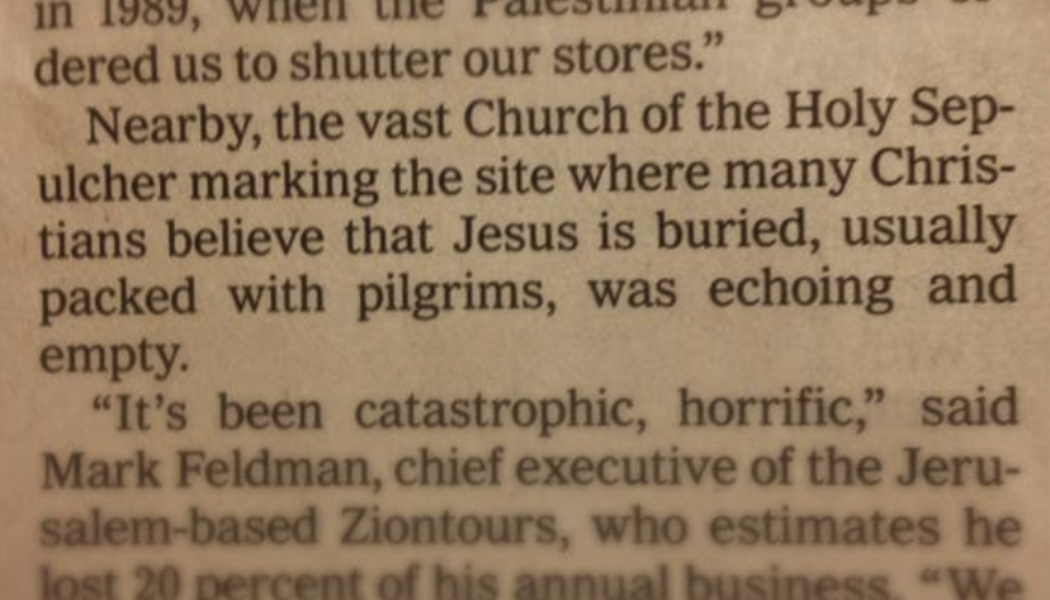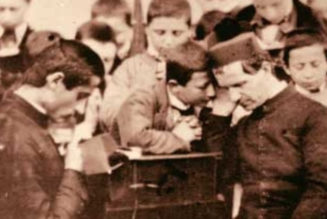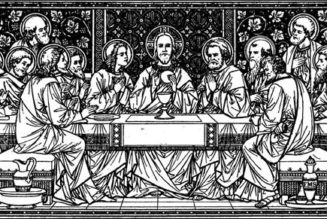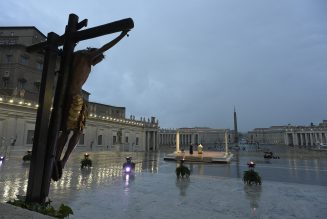If you know anything about world religions, then you know that Easter is a big deal in Christianity.
In Eastern Orthodox churches, the Big Idea is stated this way, over and over, in rites for Pascha (Easter): “Christ is risen from the dead, trampling down death by death, and upon those in the tombs bestowing life” (see this flash mob celebration in Lebanon).”
I don’t bring this up as a matter of evangelism or some other #triggerwarning behavior. I am noted that this is an essential fact about Christianity, the world’s largest religious faith. Easter isn’t a “bunny” thing.
This brings us to one of the more unusual “religion ghosts” we spotted several times during the 20-year history of GetReligion. Here’s a case study at Newsweek and another at Facebook news. However, the classic version of this ghost appeared in the holy (in journalism terms) pages of The New York Times in this 2014 feature: “Hoping War-Weary Tourists Will Return to Israel.” Here is the key passage:
On a recent afternoon in the Old City of Jerusalem, while fighting raged in Gaza, Bilal Abu Khalaf hosted a group of Israeli tourists at his textile store in the Christian Quarter — one of Jerusalem’s tourist gems. …
“That’s the first group I’ve had here in more than a month,” Mr. Abu Khalaf said. “There have been whole weeks when no one has been inside the shop. I’ve sold almost nothing the entire summer. Business hasn’t been this bad since the first intifada in 1989, when the Palestinian groups ordered us to shutter our stores.”
Nearby, the vast Church of the Holy Sepulcher marking the site where many Christians believe that Jesus was buried, usually packed with pilgrims, was echoing and empty.
Now, what’s unusual about that? Well, it helps to know that the printed version said:
Nearby, the vast Church of the Holy Sepulcher marking the site where many Christians believe that Jesus is buried, usually packed with pilgrims, was echoing and empty.
It’s all about the word “is,” isn’t it?
Inquiring minds wanted to know: Was there anyone in the editorial chain at the world’s newspaper of record who knew the essential fact that traditional Christians don’t believe Jesus is buried anywhere? It’s that whole “Easter” thing.

Now, after some heckling, that error did get fixed in the online text. But readers will not find out about this rather symbolic error via an actual correction — one in which editors note the error and apologize for it.
There is no correction for this error with this Times story. The error wasn’t worth confessing. We only know about it because readers, in the Internet age, saved images of this page (see insert) from their dead-tree-pulp edition of the Times and posted them in social media.
Why mention this in the final GetReligion post? (Remember: The website archive will remain online at this URL, which we hope will become part of an academic reference collection. And the “Crossroads” podcasts continue at multiple websites.)
Simply stated, there was a time — early in GetReligion history — when I would get calls from professionals from the copy desks in major newsrooms when we published information of this kind. Why? They wanted to correct errors.
Yes, there were calls from the New York Times. I even heard from a few reporters working on complex stories. They wanted to clarify basic facts or even to “blue sky” potential sources on both sides of hot-button issues. I was glad to help.
The calls stopped about 10 years ago. And it’s safe to say that most newsrooms are now correcting certain types of errors by changing this or that in the online texts, without public corrections.
Another observation: In the past 20 years, I have never seen a newsroom correct language in a religion story because it was nakedly biased. Also, I have never seen a story “corrected” to add quotes from obvious sources that would have balanced a report on a controversial topic or could have provided information correcting an error in history or doctrine. You see, history and doctrine are not “real.”
One more time, allow me to quote that 2004 Books & Culture piece by sociologist Christian Smith: “Religiously Ignorant Journalists — In search of Episcopals and evangelists.” The overture is essential:
Today I received a phone message from a journalist from a major Dallas newspaper who wanted to talk to me about a story he was writing about “Episcopals,” about how the controversy over the 2003 General Convention’s approval of the homosexual bishop, Gene Robinson, would affect “Episcopals.” What an embarrassment. How do I break the news to him that there are no “Episcopals”? Actually, they are called Episcopalians. Of greater concern, I wonder how this journalist is going to write an informed and informing story in a few days about such an important and complex matter when he doesn’t even know enough in starting to call his subjects by their right name.
What I have learned, however, over the years, is that this journalist is not alone in his ignorance. As a scholar of American religion promoted to journalists by my university’s PR department as an alleged expert, I constantly receive inquiries from reporters wanting background, quotes, and contacts for religion stories they are writing. Usually they have one or two days to complete the story. As often as not, the journalist mispronounces the name of the religious group he or she is covering.
“Evangelicals” is one of their favorites to botch. Often in our discussions, journalists refer to ordinary evangelical believers as “evangelists” – as if the roughly 70 million conservative Protestants in America were all traveling preachers like Billy Graham and Luis Palau. … Other journalists simply cannot pronounce “evangelicals” at all. They get confused and flustered, and after a few uncomfortable tries at “evangelics” and “evangelicalists” they give up and resort to referring to evangelicals simply as “them.”
Enough of that.
But let me note, again, why this website was created. Yes, I realize I’m echoing the post the other day in which I explained why GetReligion was closing (please read that, since it’s important background for this finale). We have consistently tried to:
(1) Promote religion-news reporting in the mainstream press, arguing that journalists on this beat deserve the respect given to those covering other complex topics in the public square. If newsroom managers want to improve religion-beat coverage, they can use ordinary journalism logic — hiring experienced (maybe even award-winning) religion-beat reporters and then letting them do their work.
(2) Note that far too many journalists (especially those at political desks) tend to miss obvious religion angles in important stories, often mangling basic facts and history in the process. The result is news coverage “haunted” by what we call “religion ghosts.” Why does this happen? As the liberal journalism icon Bill Moyers once told me, many journalists are “tone deaf” to the music of faith in public life.
(3) Defend the traditional “American Model of the Press,” with its emphasis on professional standards that stress accuracy, fairness and even balance. Many journalists seem to believe that these old-school standards do not apply to coverage of hot-button subjects linked to religion, morality and culture. After all, politics is real. Religion? Not so much.
The headline on the first GetReligion post stated: “What we do, why we do it.”
The headline on this final post echoes that: “Why we did what we did.”
Nothing changed at GetReligion. But basic facts about the journalism business have changed, as I explained in this recent essay for the Religion & Liberty journal: “The Evolving Religion of Journalism.” And see this post a year ago, as I began (privately) to grasp that it was time for GetReligion to close: “It’s just good business? The growing debate about America’s news-silo culture.”
Let me conclude with a few other observations:
* Many times, readers called GetReligion a “conservative” website because we kept stressing the need for the mainstream press to be accurate, fair-minded and even balanced when covering religious groups, on the left and right.
The basic idea we kept hearing from some readers was that there are religious groups that have beliefs that are acceptable and others that do not. There was no need to accurately report the views of believers who were, according to many newsroom leaders, wrong. You could see these tensions in a 2013 post by Bobby Ross, Jr., that ran with this headline: “Yet another one-sided AP same-sex marriage story.” I defended Bobby’s post in the comments by noting:
If the Associated Press abandons the American Model of the Press then that model is, for all practical purposes, DEAD.
So it is false equivalency to deal fairly and accurately with the views of, well, Mother Theresa, Orthodox Judaism, the Dalai Lama, Billy Graham, the majority of African-American church leaders, Martin Luther King Jr., Pope Francis and numerous others?
If reporters cannot handle this basic journalistic task then they should of their own free will work for advocacy publications committed to their doctrines on these issues.
* Another word about comments: I would say that we printed about one out of four comments that we received. The problem was that many, not all, readers wanted to yell at us or each other about politics or religion. We printed comments that, in any way, seriously engaged with the journalism issues in a post.
* The basic journalism problem today is that many major players (left and right) want to please their paying customers — the readers. However, they also want to insist that this “preaching to the choir” business model does not threaten old-school values of, yes, accuracy, fairness and balance.
This brings us to that much-used GetReligion term — “Kellerism.” That’s a reference to a 2011 appearance at the Lyndon Baines Johnson Library by Bill Keller of The New York Times, soon after he stepped down as editor. He was asked if the Times was a “liberal” newspaper and he replied (this is taken from my “On Religion” column, since the video has since been taken down):
“We are liberal in the sense that we are open-minded, sort of tolerant, urban. Our wedding page includes — and did even before New York had a gay marriage law — included gay unions. So we’re liberal in that sense of the word, I guess. Socially liberal.”
Asked directly if the Times slants its coverage to favor “Democrats and liberals,” he added: “Aside from the liberal values, sort of social values thing that I talked about, no, I don’t think that it does.”
I would argue that “aside from” are the two most important words in the GetReligion archive — out of the 20 million or so words in there (using an estimate by a tech friend of mine).
Keller insisted that his newspaper still offered accurate, fair, balanced coverage on politics and other important news topics. You know, coverage of things that are “real.” But he stated, on the record, that the Times had developed an urban, intellectual, liberal bias when covering moral and social issues. And what are America’s hot-button issues? I noted:
Any list would include sex, salvation, abortion, euthanasia, gay rights, cloning and a few other sensitive matters that are inevitably linked to religion. That’s all.
* Here is another important quote related to that theme, one that helped inspire the creation of GetReligion. It comes from a 1999 feature in the the New York Times Magazine about abortion extremists, written by David Samuels.
“It is a shared if unspoken premise of the world that most of us inhabit that absolutes do not exist and that people who claim to have found them are crazy.”
Writing at PressThink, journalism professor Jay Rosen noted:
This struck some people as dogma very close to religious dogma, and they spoke up about it. One was Terry Mattingly, a syndicated columnist of religion: “This remarkable credo was more than a statement of one journalist’s convictions, said William Proctor, a Harvard Law School graduate and former legal affairs reporter for the New York Daily News. Surely, the ‘world that most of us inhabit’ cited by Samuels is, in fact, the culture of the New York Times and the faithful who draw inspiration from its sacred pages.”
Yet here is the part that intrigued me: “But critics are wrong if they claim that the New York Times is a bastion of secularism, he stressed. In its own way, the newspaper is crusading to reform society and even to convert wayward ‘fundamentalists.’ Thus, when listing the ‘deadly sins’ that are opposed by the Times, he deliberately did not claim that it rejects religious faith. Instead, he said the world’s most influential newspaper condemns ‘the sin of religious certainty.’ “
The bottom line for many journalists: Why do accurate, fair-minded, balanced coverage of crazy people?
* Over the years, I did hear from readers on the political RIGHT who believed that GetReligion’s goal was to steer coverage in their direction. In the comments pages, that would look like this. A reader said:
NYT has become Pravda and the truth is not in it.
And another added:
Excellent post, Terry! Let’s hope that from this point forward, that the NYT will cater to the average, God-fearing, working American — the same ones who voted for Trump. I am sick of their liberal bias.
I replied:
No one here is interested in CATERING to anyone. We are interested in the viewpoints of people on both sides of crucial debates being reported with accuracy, fairness and respect. The goal, in other words, is journalism (and in a historic sense of the word, actual liberalism).
That was the beach on which we were willing to die.
* In recent weeks, I have been using the following equation to express the niche-news era in which journalists, on the left and right, now live: “Good people can do nothing bad. Bad people can do nothing good.” This is a lie, of course, and it’s dangerous when journalists are asked to live by lies.
Readers of sobering literature will also note that this equation is the opposite of the famous quote from Aleksandr Solzhenitsyn:
“The line separating good and evil passes not through states, nor between classes, nor between political parties either — but right through every human heart — and through all human hearts.”
* Finally, what can I say about the fascinating and talented team of scribes who have written for GetReligion? Also, special thanks to Fieldstead & Co. for strong support for so many years and the Overby Center at the University of Mississippi for providing us with an academic home a few years ago.
I have been asked many times what we searched for when inviting people to join the team. There have been exceptions — consider the omnipresent political scientist Ryan Burge — but most of the GetReligionistas have had significant news experience covering religion in one form or another.
A few years ago, the team consisted of Richard Ostling, Julia Duin, Ira Rifkin and Bobby Ross, Jr. Add me to that mix and we had a combined total of nearly 200 years of experience in journalism about religion. Consider the resume of Julia Duin (and don’t forget her books). Pause and look at the remarkable background of Ira Rifkin, to name another member of the team.
Some of the GetReligion bylines are better known than others. Mollie Ziegler Hemingway went on to lead The Federalist, contribute commentary on Fox News and write national bestsellers. However, her husband Mark Hemingway was also a valuable (and very witty) member of our team for several years.
I mentioned Bobby Ross, Jr. It’s important to remember the graceful GetReligion contributions of his wife, Tamie Ross, who also had years religion-beat experience. Many know the byline of Sarah Pulliam Bailey, from the Washington Post and elsewhere. However, it’s important to remember the early GetReligion posts by her brother, Daniel Pulliam, who we can hope will someday leave, or expand, his law career and return to journalism.
Then there is the patriarch, Richard Ostling, best known for his decades at Time magazine and the Associated Press. When I began working on the religion beat, I had a handful of heroes and Ostling (and Russell Chandler of the Los Angeles Times) were at the top of that list. It’s hard to believe that, after years of long-distance friendship, the Internet allowed me to write and edit with him for a decade here at GetReligion. Imagine that.
Also, I will offer a final word of thanks to my friend (and dare I say, fellow curmudgeon) Doug LeBlanc. He helped create the basic structures of GetReligion, including our antique typewriter-meets-Gutenberg logo). This format stood the test of time, even as we migrated from one software universe to another.
My final word to all of them: Axios.









